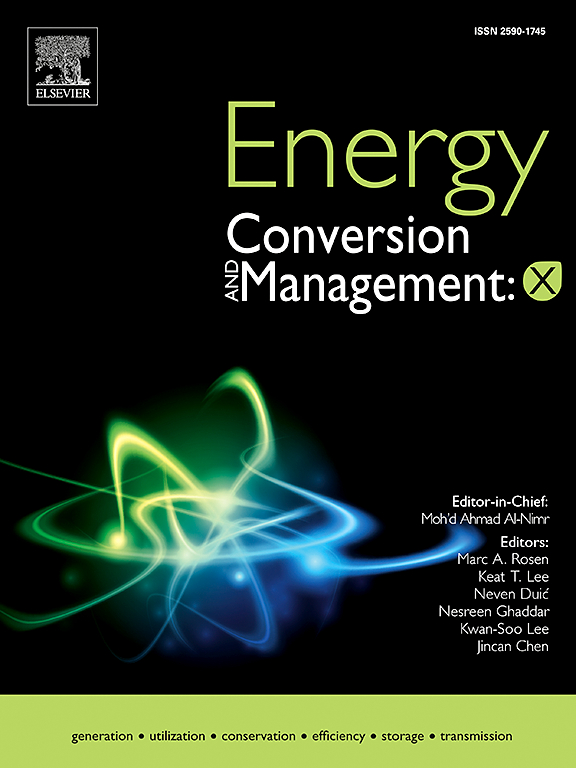实时变化入流湍流下风力机尾迹动力学:相干模式视角
IF 10.9
1区 工程技术
Q1 ENERGY & FUELS
引用次数: 0
摘要
湍流对风力机的气动性能和尾迹动力学起着至关重要的作用;然而,目前的数值模拟研究往往忽略了其影响或通过建模将其简化,导致与现实情况有很大的偏差和差异。为了解决这一差距,本研究提出了一种主动窄带综合随机流生成方法,用于国家可再生能源实验室海上5mw风机进口实时入流湍流生成,采用大涡模拟。本研究考察了湍流对风力机尾迹涡动力学的影响,采用高阶动力模态分解分析相干模态。结果表明,湍流度和叶尖速比对风力机气动性能有显著影响。湍流改变了尾流的速度分布,产生了一个更加倾斜的w形结构,同时增强了特定频率下的波动风能。此外,湍流的影响主要集中在fn = 1和fn = 2的模式中,湍流破坏了远尾流叶尖涡的稳定性,而在高叶尖速比下保持了近尾流涡的稳定性。随着旋翼转速的降低,湍流对尾流特性的影响越来越大。本研究的结论是,湍流,特别是当与叶尖速比的降低相结合时,加速了叶尖涡的不稳定,导致近尾迹中更复杂的涡结构。本文章由计算机程序翻译,如有差异,请以英文原文为准。

Wake dynamics of a wind turbine under real-time varying inflow turbulence: A coherence mode perspective
Turbulence plays a pivotal role in the aerodynamic performance and wake dynamics of wind turbines; however, current numerical simulation studies often overlook its effects or simplify them through modeling, leading to significant deviations and discrepancies from real-world conditions. To address this gap, this study proposes an active narrowband synthesis random flow generation method for real-time inflow turbulence generation at the inlet of the National Renewable Energy Laboratory’s offshore 5 MW wind turbine using large eddy simulation. This study examined the impact of turbulence on vortex dynamics in the wind turbine wake, employing higher-order dynamic mode decomposition to analyze coherent modes. The results indicate that turbulence and tip speed ratio significantly influence the aerodynamic behavior of the wind turbine. The turbulence alters the wake’s velocity distribution, producing a more skewed, oblique W-shaped configuration, while enhancing fluctuating wind energy at specific frequencies. Additionally, the effects of turbulence are predominantly concentrated in the modes with fn = 1 and fn = 2, with turbulence disrupting the stability of tip vortices in the far wake while preserving the stability of near-wake vortices at high tip speed ratios. As rotor speed decreases, turbulent effects increasingly dominate the wake vortex characteristics. This study concludes that turbulence, particularly when combined with a reduction in tip speed ratio, accelerates the destabilization of tip vortices, leading to more complex vortex structures in the near wake.
求助全文
通过发布文献求助,成功后即可免费获取论文全文。
去求助
来源期刊

Energy Conversion and Management
工程技术-力学
CiteScore
19.00
自引率
11.50%
发文量
1304
审稿时长
17 days
期刊介绍:
The journal Energy Conversion and Management provides a forum for publishing original contributions and comprehensive technical review articles of interdisciplinary and original research on all important energy topics.
The topics considered include energy generation, utilization, conversion, storage, transmission, conservation, management and sustainability. These topics typically involve various types of energy such as mechanical, thermal, nuclear, chemical, electromagnetic, magnetic and electric. These energy types cover all known energy resources, including renewable resources (e.g., solar, bio, hydro, wind, geothermal and ocean energy), fossil fuels and nuclear resources.
 求助内容:
求助内容: 应助结果提醒方式:
应助结果提醒方式:


